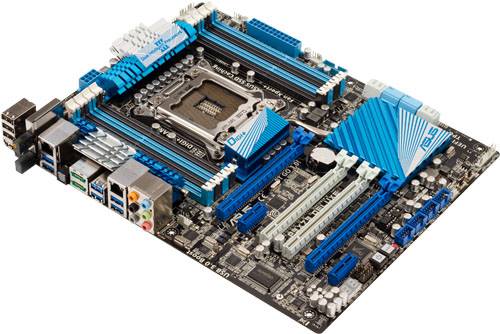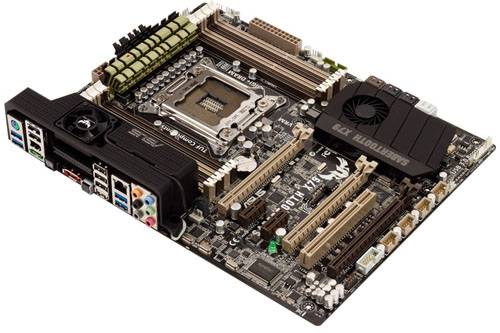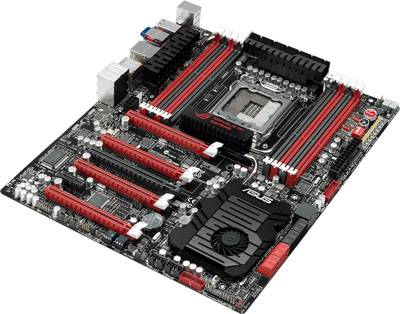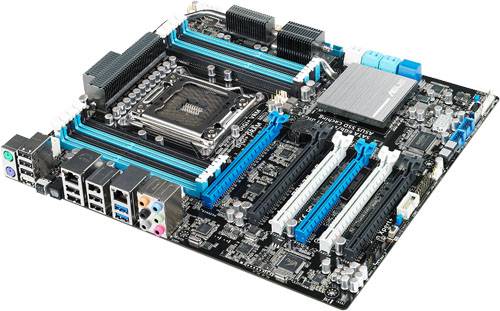- Qualcomm Launches Snapdragon 4 Gen 2 Mobile Platform
- AMD Launches Ryzen PRO 7000 Series Mobile & Desktop Platform
- Intel Launches Sleek Single-Slot Arc Pro A60 Workstation Graphics Card
- NVIDIA Announces Latest Ada Lovelace Additions: GeForce RTX 4060 Ti & RTX 4060
- Maxon Redshift With AMD Radeon GPU Rendering Support Now Available
ASUS X79 Motherboard Preview
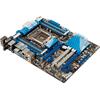
At its annual tech summit held a couple of weeks ago, ASUS talked in great detail about what’s coming to its X79 mobo line-up. Certain NDA’s have not yet lifted, but we can talk about a few of the new things ASUS is introducing, and also take an early look at four of the company’s X79 motherboards.
Page 2 – A Look at the Boards
Bringing out the boards, the P9X79 family will fill the role of the mainstream motherboards and will include at least four separate models, one of which has been somehow condensed into the mATX form factor.
There will be the standard Deluxe, Pro, and vanilla offerings, but ASUS made it clear that even the vanilla model will retain all core functionality included in the P9X79 Deluxe. This includes the digital PWM circuitry and all eight memory slots. All P9X79 boards will include four fan headers in addition to the processor fan header, and all will allow customized control from within ASUS’ extensive fan control suite.
The TUF Sabertooth X79 board is ruggedized and built to exceed even server-grade testing requirements, with past TUF series boards having earned quite a reputation for the best cooling and stability in their class. For the uninitiated, the TUF series uses military grade electrical components to guarantee dependability, comes with an extensive certificate of reliability that details the hardware, and an extended warranty to back it all up.
The Sabertooth X79 continues this tradition with a new design for the thermal armor that includes a chipset fan and a second fan for the back I/O panel and digital PWM area. Because of the addition of these fans, the X79 Sabertooth will feature an additional two fan headers for a total of six, all of them offering the full range of ASUS’ excellent fan control options. ASUS is also touting its new “Thermal Radar” technology, which consists of 12 embedded sensors to monitor temperatures throughout the motherboard and will allow better fan response when additional cooling is needed.
The ROG Rampage IV Extreme will be the flagship motherboard for the Republic of Gamers series, but the breadth of features combined with a few new tricks is going to make this board a must-have for extreme overclockers, benchmarkers, and gamers alike. RoG’s new X79 board will include every trick in the book to boost overclocking, but includes some features that especially aid subzero benchmarking.
Let’s start with pure overclocking. The Rampage IV Extreme will include a little goodie called the “OC Key”, and what this will do is tie into the GPU output feed, enabling an on screen display that bypasses the system CPU and gives full status information from ASUS’ AI Suite. This will be most attractive to extreme benchers that perform manual on-the-fly tweaking mid-benchmark and want every ounce of CPU time to go towards the final score.
Sub-zero cooling is never cheap, and ASUS has implemented some ingenious tricks to make the Rampage IV Extreme particularly appealing to those benching on a budget. The first is the X-socket. The Rampage IV Extreme will allow users to remove the existing socket plate and replace it with an included special plate kit that allows subzero benchers to reuse the same LN2 pots or phase coolers that are designed to mount to the X58 backplate.
The second is termed “Subzero Sense”. On the backplane there are two ports to connect thermal probes to a bencher’s multimeter, designed especially to allow temperature monitoring of the CPU and GPU when LN2 pots are attached to the system. Benchers can simply use one monitoring device to quickly swap between stations instead of requiring an entire bank of pre-configured multimeters to monitor temps. There’s still a few more tricks included in the Republic of Gamers box, but full details will have to be given at the launch date.
For those that are looking for high-quality, feature-laden workstation motherboards, ASUS has a few of those too. The company has other workstation class motherboards, but as much as we want to, we unfortunately we cannot discuss them at this time. But what we can tell you, is that the EVGA SR-3 will no longer be the only choice this time around. ;)
Discuss this article in our forums!
Have a comment you wish to make on this article? Recommendations? Criticism? Feel free to head over to our related thread and put your words to our virtual paper! There is no requirement to register in order to respond to these threads, but it sure doesn’t hurt!
Support our efforts! With ad revenue at an all-time low for written websites, we're relying more than ever on reader support to help us continue putting so much effort into this type of content. You can support us by becoming a Patron, or by using our Amazon shopping affiliate links listed through our articles. Thanks for your support!




